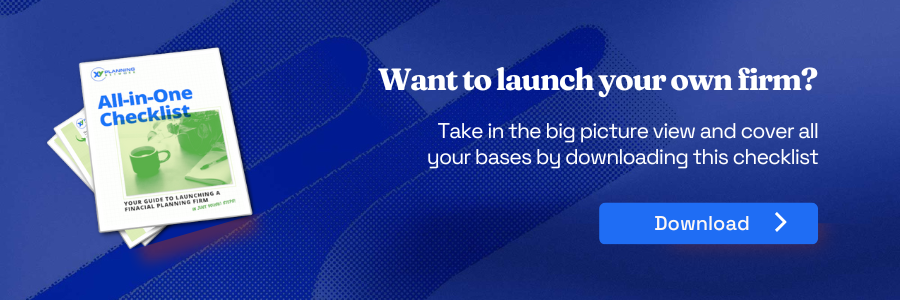7 Things to Do Before You Launch Your Financial Planning Firm: What Would Arlene Say?
Share this
I talk to a lot of advisors who are gearing up to launch their firms. The world can never have enough fee-for-service financial planners, and I guarantee there are a fantastic group of clients out there just waiting for your unique planning style, personality, and experiences.
Unfortunately, not all financial planners feel prepared to strike out on their own.
Launching your own firm is exciting, but it can also be incredibly stressful. Putting some legwork in ahead of your launch can help prevent a lot of headaches once you get started.
You want to make sure you’re completely ready to hit the ground running, or at least as ready as anyone can be when they launch their own business.
These seven steps can help you start to lay the groundwork to successfully launch your own fee-for-service financial planning firm.
#1: Build Your Business Plan
Your business plan needs to have three things:
-
Your mission statement.
-
Your vision statement.
-
Your core values.
These three things will help guide you through the years and give you some inspiration to keep going, even when things are tough during your early days of business development.
Through your mission, vision, and core values, you can start to put a plan in place for your business and turn your dream into a reality.
Mission Statement
What’s your core purpose? Why does your company exist? These are big questions, but your job is to sum them up in a clear, concise sentence (or two) for your company.
Your mission statement is internal and external. It will help keep you on course, inspire your future team, draw in prospective clients, and help you connect with referral sources.
In short, your mission statement needs to capture who you are so you can draw those into your business who are the best possible fit to either work with you or support you in your growth.
It’s not uncommon for advisors to hit a block when putting together a mission statement. The thought of boiling down all of your hopes, dreams, and your purpose into a one-sentence elevator pitch seems pretty impossible.
Stick with these building blocks to get started:
-
Actions
-
Services
-
Problems
-
Beneficiaries
Take the time to brainstorm as many of these building blocks as you can, then narrow it down to what truly represents you and your firm. Sometimes, a full-blown brain-dump is what it takes to get all of your ideas down on paper and figure out what sticks for you and your future vision for your business.
Remember, your mission statement should be short—no more than 15-20 words. It should also be written at an 8th, maybe 10th-grade reading level. Don’t use any jargon or industry slang.
You want your mission statement to resonate with your target clients, not other advisors (unless of course they are your target audience).
Vision Statement
This is similar to your mission statement, but it’s much more future-focused. Your vision statement is mostly used internally, although it can be helpful to talk to prospective clients about where you’re growing to as a firm.
Your vision statement should cover what you’re looking to accomplish in the mid- and long-term future, how you define success, and how the world will be different as a result of your work.
Again, just like with your mission statement, being concise is key here. You want 5-15 words total in your sentence. Stick with simple terms that are easy for everyone to wrap their heads around.
Core Values
What core values does your company operate under? Brainstorm all the words you believe describe you and your firm and determine which feel like the best fit. Skip any words that people expect any business owners to adhere to; people don’t need to know you’re responsible or hard-working. Your clients and future team members will expect that of you.
Instead, think of 5-6 words that really have an impact and set you apart. Feel free to list your core values separately or use them in a sentence.
#2: Evaluate Your Pain Points and Strengths
It’s time for the next step in your firm launch strategy: conducting a SWOT analysis.
S - Strengths
W - Weaknesses
O - Opportunities
T - Threats
If this concept seems a little intimidating, simplify things by looking at advantages and barriers. Everyone can think of their barriers pretty easily, so let’s start with the real challenge here: thinking of your advantages. Really let this settle in. Don’t sell yourself short!
Your advantages might be your natural network. For example, if you left a former profession or industry to pursue financial planning, you might be a natural fit to serve employees still working in your ex-field of choice. You might have expertise in non-financial areas, or in specific areas of financial planning. Even your life experience can be a huge benefit.
I spoke with someone recently who wasn’t sure what their advantages were before starting their firm. Then he told me his life story. He had faced every imaginable life challenge, from losing his parents, to growing up in poverty, to struggling with a wide range of personal tragedies throughout his young adult life.
I wanted to shake him. His experience could help so many people through similar situations in ways that nobody else would be able to. His tragedy was going to help him have a positive impact on the lives of others, and he hadn’t ever thought about it that way.
When it comes to thinking of your advantages, turn what you previously thought of as negatives into positives. Think about how the trials you’ve walked through can push you to better serve your clients.
Now, let’s talk about your barriers to entry.
Most advisors can think of a mile-long list of barriers. People almost always see the hurdles they face more clearly than the advantages they have.
Don’t dwell on your barriers too long, but do list them out, and start to think about strategies you can use to break through them.
A few barriers to entry might be:
-
You’re new in a small town
-
You’re painfully shy
-
You have a number of larger, high-profile firms in your area
Every barrier can be overcome with a bit of creative thinking. Sometimes, you may be creating your own barriers because you’re unwilling to think outside of the box. The more you’re willing to tackle your barriers before you launch, the more likely you’ll be to move past them as a new RIA.
#3: Set a Budget
Most advisors have heard that it’s important to set a budget as a new RIA owner, but aren’t sure how to go about it.
Personally, I don’t believe you can feasibly plan past the first two years of business. Beyond that, there are so many unknowns, any plans you make will probably be irrelevant by the time you get there.
Instead, focus on planning as much as you can for your first two years. Ask yourself: what’s it going to cost to run for two years? Think about everything that goes into your practice—every expense.
A few key tips here:
-
Be realistic. Don’t just assume you’ll run things on a shoestring budget, and don’t think that you’ll have enough revenue to start pulling a 6-figure salary in Month 3. Set realistic goals and expectations for yourself.
-
Have a safety net. There’s no telling how long it will take you to work through some initial hurdles in your launch, and you’ll need to pay the bills and, you know, eat. Don’t launch without a safety net built out! Figure out what you need in the bank to make your business happen for two years - both personally and professionally.
-
Be conservative in your spending. It’s easy to commit to a billion different software programs, shiny new tools, and hiring help with every part of your business that isn’t signing on new prospects. Unfortunately, you’re going to need to take on some of those tasks yourself in the first few years. Pick and choose what you want to outsource, and focus on building an efficient and streamlined tech stack to keep spending low.
You can also start to plan for your first two years of business revenue. Again, the key here is to set conservative client growth goals for years one and two of your business.
You can do this two ways: you can either set goals for your total revenue or your revenue per client. The more you can realistically project these numbers, the more you can plan the timing for different purchases or investments in your business.
Your plan isn’t going to be perfect, but it’s certainly better than flying blind.
#4: Figure Out Your Service Offerings
Once you’ve built your business plan and estimated your budget, you need to figure out your service offerings. To decide the types of services you want to offer, you need to determine your target market, service offering, and fees. These three pieces fit together to create the full picture for your business. All three work together to help you grow your business.
Start by thinking about who you want to work with. What does your niche need? How will your niche pay for your services? Typically, I recommend that you do the income sanity test. In general, people won’t pay more than 1-2% of their annual salary for your services. If you’re targeting new graduates and charging high fees, you may need to adjust.
It’s important you don’t mismatch client type with the wrong service offering. Once you determine who your ideal clients are, you can think about the type of services they need. Retirees need a different service model than millennial entrepreneurs. Build your service offerings according to what the people you want to serve need most. Then, think about the best fee structure to support those services.
#5: Estimate Client Growth Rate
This is a big part of your business’s launch plan, but it can be tough to estimate. Typically, I start by telling clients to stop the comparison game. It’s easy to see someone launch their firm and sign on 50 clients in the first three months of business, then put up a waitlist, and to feel completely deflated. The truth is that client growth rate depends on what you are doing, who you are serving, and how you’re serving them.
For some, planning is front-loaded, so their client growth rate will be slower. Say you’re signing on one or two new clients a month, but each of those clients takes a long time to get organized and kick off the planning process. Then, once they’re fully onboarded, their ongoing work switches into maintenance mode with occasional proactive planning that needs to happen. In this case, slow growth may be better! You don’t want to burn yourself out by signing on too many clients who all need a lot of hand-holding in the beginning few months of your relationship.
Figure out what numbers make the most sense for you and your unique service offering. It’s helpful to think about your service offering and ideal client before you think about client growth rate for this exact reason.
You need to set your growth goals based on your clients, not based on how big of a firm you want to build. This is a tough mental barrier to overcome, but if you can always set growth goals that are client-serving, your business will grow more successfully.
#6: Figure Out a Marketing and Sales Strategy
At this point, you’ve thought about your business plan, barriers and advantages, your budget, your services, and your growth goals. These are all of the elements you need to start thinking through your marketing and sales strategies.
You know your ideal audience, you know your values and mission, and you know your growth goals. Now you need to ask yourself some intentional questions:
-
How can I reach and connect with my ideal audience?
-
What’s the best way to communicate my value?
-
What sales strategies line up with my values and my mission?
-
What marketing tactics can help me reach my growth goals?
There are so many different ways to “sell”, or rather to market, your services. You can pursue content marketing, local marketing, webinars, in-person events, COI campaigns…the list goes on and on.
It’s easy for a new RIA owner to feel like they’re drowning in possibilities. Instead of trying to do everything at once, take the time before your launch to do some research.
Make a list of what marketing strategies feel comfortable for you, and what you think will reach and convert your ideal clients. You might start with one or two strategies that you feel confident about, such as:
-
Sharing your content on social media
-
Growing your referral network
-
Meeting with COIs in your area
-
Developing a lead magnet to grow your email list
Next, mull over how you want your sales process to look. It can help to have a set system in place before your launch. For example, you may:
-
Start with a 15-minute coffee chat meeting.
-
Book an initial consultation if you mutually feel you’re a good fit.
-
Use this initial consultation as a discovery call.
-
Review your services and rates on the discovery call.
-
Book a final follow-up meeting if they have any questions or move them through the onboarding process if they’re ready.
#7: Get Your Registration Together
State registration is one of the most time-consuming and stressful parts of your launch plan, so it pays to be prepared.
To pass your state registration, you’ll likely need either:
-
To have passed your Series 66 or 7 exam
-
Have one of the following registrations in good standing: Certified Financial Planner® (CFP®), Chartered Financial Analyst (CFA), Chartered Investment Counselor (CIC), Chartered Financial Consultant (ChFC), or Personal Financial Specialist (PFS)
You’ll also need:
-
A name for your firm
-
An established business entity
-
A bank account for your RIA
-
Clear contact information
Once you have these elements pulled together, it’s time to submit your FINRA SAA Form. In addition to everything here, you’ll need to know your services in order to register. This is why working through some of the initial legwork, brainstorming, and research in Steps #1-6 can be helpful before registering.
Ready to Launch?
The more you can project your future business development goals, the more you’ll set yourself up for success in the first two years of your business.
As you work through this to-do list, keep in mind that you want to create a firm that both you and your ideal clients will love. If you build something you’re passionate about and that serves your niche well, then you’ve already won half the battle.
 About Arlene Moss, Executive Coach
About Arlene Moss, Executive Coach
Arlene gets a kick out of helping financial advisors get over being overwhelmed and take on their frustrations so their businesses soar. Arlene works to ensure XYPN members are able to help their clients prosper while creating a sustainable business model. Through XYPN Academy and one-on-one coaching, members get the support they need to grow their businesses and overcome the challenges that come their way.
Share this
- Advisor Blog (719)
- Financial Advisors (242)
- Growing an RIA (128)
- Business Development (93)
- Digital Marketing (93)
- Marketing (90)
- Community (82)
- Start an RIA (76)
- Coaching (73)
- Running an RIA (72)
- Compliance (70)
- Client Acquisition (68)
- Technology (67)
- Entrepreneurship (64)
- XYPN LIVE (64)
- Fee-only advisor (49)
- Sales (49)
- Bookkeeping (46)
- Client Engagement (45)
- Practice Management (44)
- XYPN Books (43)
- Scaling an RIA (42)
- Investment Management (41)
- Client Services (31)
- Employee Engagement (31)
- Lifestyle, Family, & Personal Finance (31)
- Financial Education & Resources (29)
- Market Trends (24)
- Journey Makers (23)
- Process (18)
- Niche (12)
- SEO (9)
- Career Change (8)
- Partnership (8)
- Transitioning Your Business (7)
- Sapphire (6)
- Transitioning To Fee-Only (4)
- Emerald (3)
- Persona (3)
- Social Media (3)
- Transitioning Clients (3)
- RIA (2)
- Onboarding (1)
Subscribe by email
You May Also Like
These Related Stories

YOU ARE MORE READY THAN YOU THINK!: What Would Arlene Say?
Jul 20, 2017
5 min read

Sick Days For Business Owners: Why They're Necessary (and Will Help Your Business Grow!) - What Would Arlene Say?
Nov 2, 2017
4 min read






